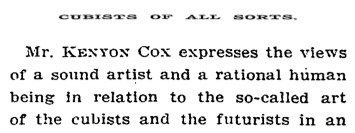
Mr. Kenyon Cox expresses the views of a sound artist and a rational human being in relation to the so-called art of the cubists and the futurists in an interview reported in the Magazine Section of THE SUNDAY TIMES. The cant of these people already fills the air. We all know too well that judgment of their silliness by common-sense methods will not avail to silence them. They may all be arrant humbugs, or some of them may be weak-minded persons who really believe their unintelligible markings and scratches signify something. Mr. Cox. well says:
This is not a sudden disruption or eruption in the history of art. It is the inevitable result of a tendency which has grown stronger and stronger during the last fifty years.
We need not dwell upon this branch of a particularly painful subject. Mr. Cox really says all there is to say about cubist “art.” But it should be borne in mind that this movement is surely a part of the general movement, discernible all over the world, to disrupt and degrade, if not to destroy, not only art, but literature and society, too. There is a kind of insanity extant which had its remote origin, it must be said, in the earlier developments of the democratic spirit. Its kinship to true democracy and to real freedom in thought, action, or expression, however, is slight and indefinite, but the cubists and futurists are own cousins to the anarchists in politics, the poets who defy syntax and decency, and all the would-be destroyers who with the pretense of trying to regenerate the world are really trying to block the wheels of progress in every direction.
There have been cubists and futurists in religion who have made of faith a mockery, that have their counterparts not only in politics but in all forms of art, including music, in the industrial movements and in philanthropy as well. Their only need seems to be that all that is old is bad, all that has been proved is false, all that has been cherished should be destroyed, all that is beautiful should be despised, all that is obvious should be ignored. Their power is wholly negative, they have nothing to replace the things they would exterminate.
They have no true message to impart, but there is no room, nevertheless, to doubt the potency of their appeal to many of the disheartened, embittered, and discontented, as well as the mentally ill-balanced. Of course, they will not destroy art, supplant literature with ribald nonsense, abolish economic law, or permanently retard the growth of nations. But we have no present hope that their influence will not grow and produce evil results. The mirth they cause encourages them, the ridicule they receive actually strengthens them. The only influence that can overcome them is sound education. What the cubist artists show is false art. The reasoning of their brothers in other fields is false. In fighting cubists of all sorts the trustworthy weapon is the truth. [Emphasis added.]
– A New York Times editorial, published March 16, 1913 condemning, among others, Brancusi, Duchamp, Matisse, and Rodin [nytimes.com]
Related: CUBISTS AND FUTURISTS ARE MAKING INSANITY PAY, by Kenyon Cox, National Academy of Art, March 16, 1913 [nyt]
